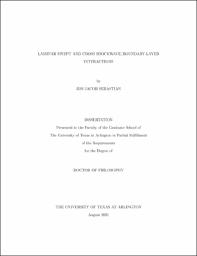
ATTENTION: The works hosted here are being migrated to a new repository that will consolidate resources, improve discoverability, and better show UTA's research impact on the global community. We will update authors as the migration progresses. Please see MavMatrix for more information.
Show simple item record
| dc.contributor.advisor | Lu, Frank K | |
| dc.creator | Sebastian, Jiss Jacob | |
| dc.date.accessioned | 2021-09-14T15:32:21Z | |
| dc.date.available | 2021-09-14T15:32:21Z | |
| dc.date.created | 2021-08 | |
| dc.date.issued | 2021-08-02 | |
| dc.date.submitted | August 2021 | |
| dc.identifier.uri | http://hdl.handle.net/10106/30004 | |
| dc.description.abstract | Shockwave/boundary-layer interactions are considered one of the most complex problems in high-speed gas dynamics, and numerous studies have been carried out for more than eighty years to understand the fundamental physics. A numerical study was performed using fin-plate configurations to study the three-dimensional swept and cross shockwave/ laminar boundary-layer interactions. All the interactions studied were strong enough for the boundary layer to separate. In the first part, swept shock interactions between a laminar boundary layer and the shockwave induced by a sharp fin mounted perpendicularly on a flat plate were studied. Different flow conditions were investigated at freestream Mach numbers of 2.64, 2.95, 3.44, and 3.93, and the fin angles of 10, 13, 16, and 19 deg. Surface flow features pertinent to fin-induced interactions such as the upstream influence, separation, and attachment lines were identified, and the presence of multiple flow separations in the interaction region was studied. Quasiconical symmetry, as previously observed for turbulent interactions, was established in laminar fin-induced interactions from the results of surface topology and surface pressure distribution. Further examination revealed that there is an inception zone near the fin apex followed by a farfield zone that appears to radiate from a virtual conical origin, bounded by the flow features and the inviscid shock trace. A new upstream-influence scaling law was proposed for laminar interactions that is different from turbulent ones and verified for a combination of Mach number, fin angle, and Reynolds number. An extension of two-dimensional free interaction theory was developed and confirmed in three-dimensional laminar fin-induced shockwave/boundary-layer interactions. Next, the separated flowfield associated with a crossing shockwave/laminar boundary-layer interactions at Mach 4 was studied. The crossing shocks were generated by a pair of symmetric, opposing fins placed on a flat plate at 7, 9, 11 and 13 deg angle of attack. The separated flowfield was found to constitute a pair of open separated counter-rotating vortical structures moving downstream. The large extent of the upstream influence in laminar interactions resulted in the deviation from quasiconical symmetry observed in single fin-induced interactions due to the relative narrow gap between the fins. The flow structures were qualitatively compared with the turbulent crossing shock interaction studies to identify and discuss the separated flow regimes. The spanwise surface pressure distributions were studied at different streamwise locations to interpret the nature of the separated flowfield and various topological features identified. | |
| dc.format.mimetype | application/pdf | |
| dc.language.iso | en_US | |
| dc.subject | Laminar | |
| dc.subject | Shockwave/boundary-layer interactions | |
| dc.subject | Swept shock interactions | |
| dc.subject | Crossing shock interactions | |
| dc.title | LAMINAR SWEPT AND CROSS SHOCKWAVE/BOUNDARY-LAYER INTERACTIONS | |
| dc.type | Thesis | |
| dc.degree.department | Mechanical and Aerospace Engineering | |
| dc.degree.name | Doctor of Philosophy in Aerospace Engineering | |
| dc.date.updated | 2021-09-14T15:32:21Z | |
| thesis.degree.department | Mechanical and Aerospace Engineering | |
| thesis.degree.grantor | The University of Texas at Arlington | |
| thesis.degree.level | Doctoral | |
| thesis.degree.name | Doctor of Philosophy in Aerospace Engineering | |
| dc.type.material | text | |
| dc.creator.orcid | 0000-0002-8932-0048 | |
Files in this item
- Name:
- SEBASTIAN-DISSERTATION-2021.pdf
- Size:
- 18.07Mb
- Format:
- PDF
This item appears in the following Collection(s)
Show simple item record


